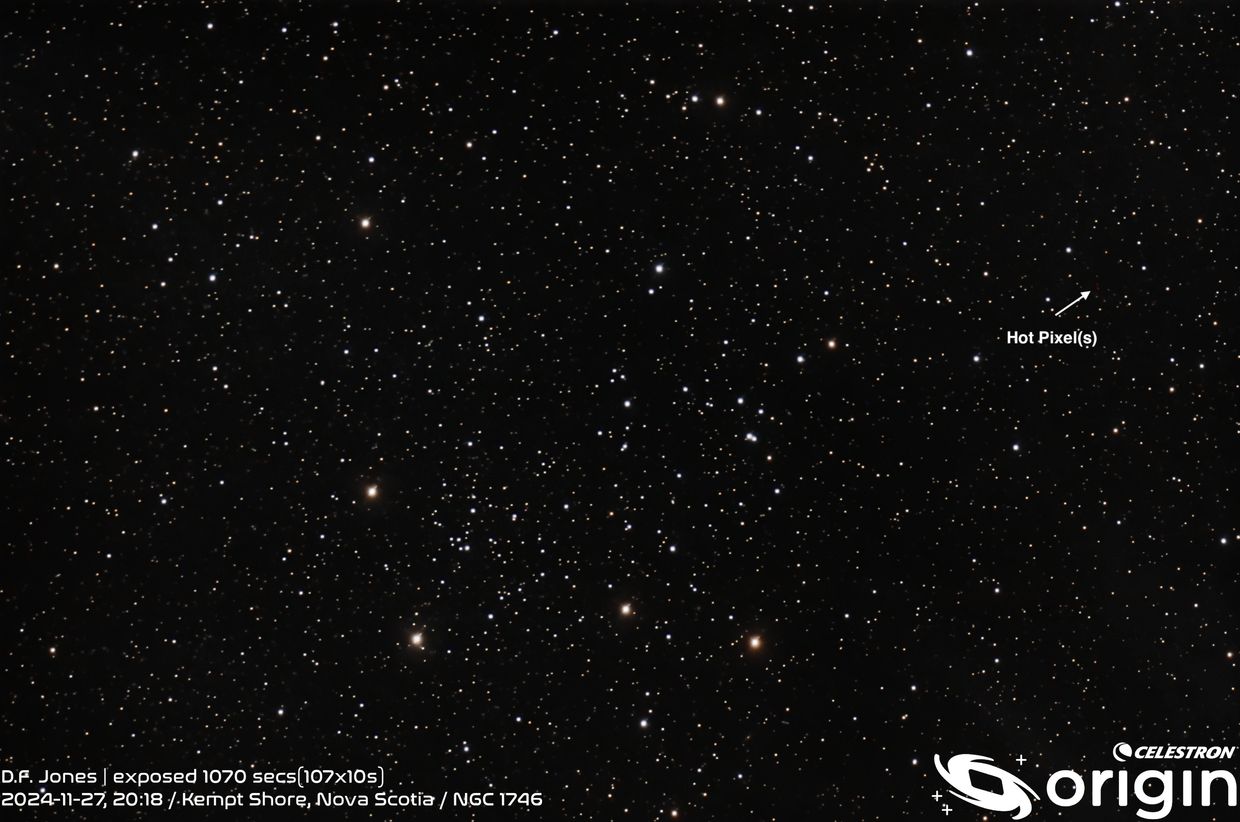Signed in as:
filler@godaddy.com
Signed in as:
filler@godaddy.com

Although Celestron has not included an operating outdoor temperature range in their specifications data, they have recommended -5°C to 40°C in their online FAQ section. For users located in northern (or southern) climates where winter temperatures are often lower than -5°C, this could be an important issue affecting purchasing decisions. It is also important to note that Celestron has not stated what the adverse effects of cold temperatures might be on Origin's optical, electrical, and mechanical systems.
As a retired scientist, I decided to make this low temperature limitation a research project for the 2024-25 winter. This was a risk I took in order to provide Celestron useful feedback for this amazing technology. The sections that follow are arranged in order of decreasing temperatures.
Dennis F. Jones


This image, centred on 73 Orionis (HD 43247), was taken during an overnight session that started at 7:51 pm on October 28, 2024 and ended at 7:07 am the following day. The outdoor temperature at the time of this capture was -1°C. Origin performed normally throughout the 11 hour session.

This image, centred on NGC 891, was taken at 7:11 pm on December 4, 2024. The session started at 5:30 pm at -3°C and ended by 8:00 pm with an outdoor temperature dropping to -5°C. This is the lower operating temperature recommended by Celestron. Origin performed normally throughout the session.

This image of Comet C 2023 A3 (Tsuchinshan-ATLAS), centred on HD 184364, was taken at 5:47 pm on December 23, 2024. The session started at 5:35 pm and ended at 7:20 pm with an outdoor temperature -8°C. Origin performed normally throughout the session of about 2 hours.

This image of nebula Sharpless 2-132 in Cepheus was taken at 6:24 pm on February 12, 2025. The session started at 6:20 pm and ended at 10:30 pm with an outdoor temperature -10°C. Origin performed normally throughout the session of about 4 hours.
Although Origin performed normally from mechanical and electrical standpoints, an optical issue did arise. I reported this issue to Celestron and they explained what I observed. I will present this topic in the next section.

This image of open cluster NGC 1746 in Taurus was taken at 8:18 pm on one of the first chilly nights in the fall - November 27, 2024. The session started at 7:24 pm and ended at 8:58 pm due to cloud cover. The outdoor temperature was 3°C. Red dots/streak were observed in the image shown by the arrow. I didn't notice this at first but when I did, I sent Celestron Tech Support the image and they explained to me it was a hot pixel. The cause of hot pixels is found in the FAQ sheet on their website. I quote
"If you notice some red “hot pixels” or other image artifacts, we recommend using “Recapture Dark Frames” in Menu>Settings>Advanced. The dark frames stored on Origin were taken at the factory and may not perfectly match your current observing conditions (i.e. temperature). Capturing the dark frames in the same conditions you are imaging will better eliminate any residual hot pixels or artifacts. NOTE: Be sure to install the dust cover on Origin before recapturing dark frames, we also recommend doing this outside at night, or in a dark room, and covering the entire optical tube with a towel or blanket to block any stray light."
I decided not to recapture dark frames for several reasons: (1) I do not want to adversely affect my long term studies (ex. variables) by changing any of Origin's factory settings, (2) What if I make a mess that is far worse?, and (3) I want to see if these hot pixels will self-repair once the warmer summer nights return. Furthermore, if I did recapture dark frames, what temperature do I use and, is this problem going to keep recurring every winter?
In the following section I am going to post a consistent capture of a star field I can see year round to monitor changes in the hot pixels/streaks. I have chosen 5 Ursae Minoris with 10-sec exposures, 10-minute total integration time, no filter, and no post-processing.

This image centred on 5 Ursae Minoris was taken at 7:38 pm on February 28, 2025. The session started at 6:44 pm and ended by 9 pm. The outdoor temperature was -1°C. Red dots/streak can be seen in the image shown by the arrow.

This image centred on 5 Ursae Minoris was taken at 8:14 pm on March 19, 2025. The session started at 8:10 pm. The outdoor temperature was 7°C. Red dots/streak have disappeared.

This image centred on 5 Ursae Minoris was taken the same night as the previous image. The temperature dropped from 7°C at 8:14 pm to 1°C at 10:26 pm on March 19, 2025. A red streak has reappeared. These results can now let me conclude that hot pixels/streaks may begin to occur between 3°C and 7°C. Lower temperatures may lead to more hot pixel/streaks and perhaps even dead pixels. I am not going to go there and risk damaging Origin's sensor!

This image centred on 5 Ursae Minoris was taken at 9:31 pm on April 30, 2025. The session started at 9:08 pm. The outdoor temperature was 11°C. Red dots/streak are visible.

This image centred on 5 Ursae Minoris was taken at 11:01 pm on June 21, 2025. The session started at 10:08 pm. The outdoor temperature was 19°C. Red dots/streak are visible. In some of the other captures on this evening, two hot pixels are visible in different locations.

This image centred on 5 Ursae Minoris was taken at 10:57 pm on July 18, 2025. The session started at 9:50 pm. The outdoor temperature was 22°C. Red dots and blue streaks are visible.
We use cookies to analyze website traffic and optimize your website experience. By accepting our use of cookies, your data will be aggregated with all other user data.